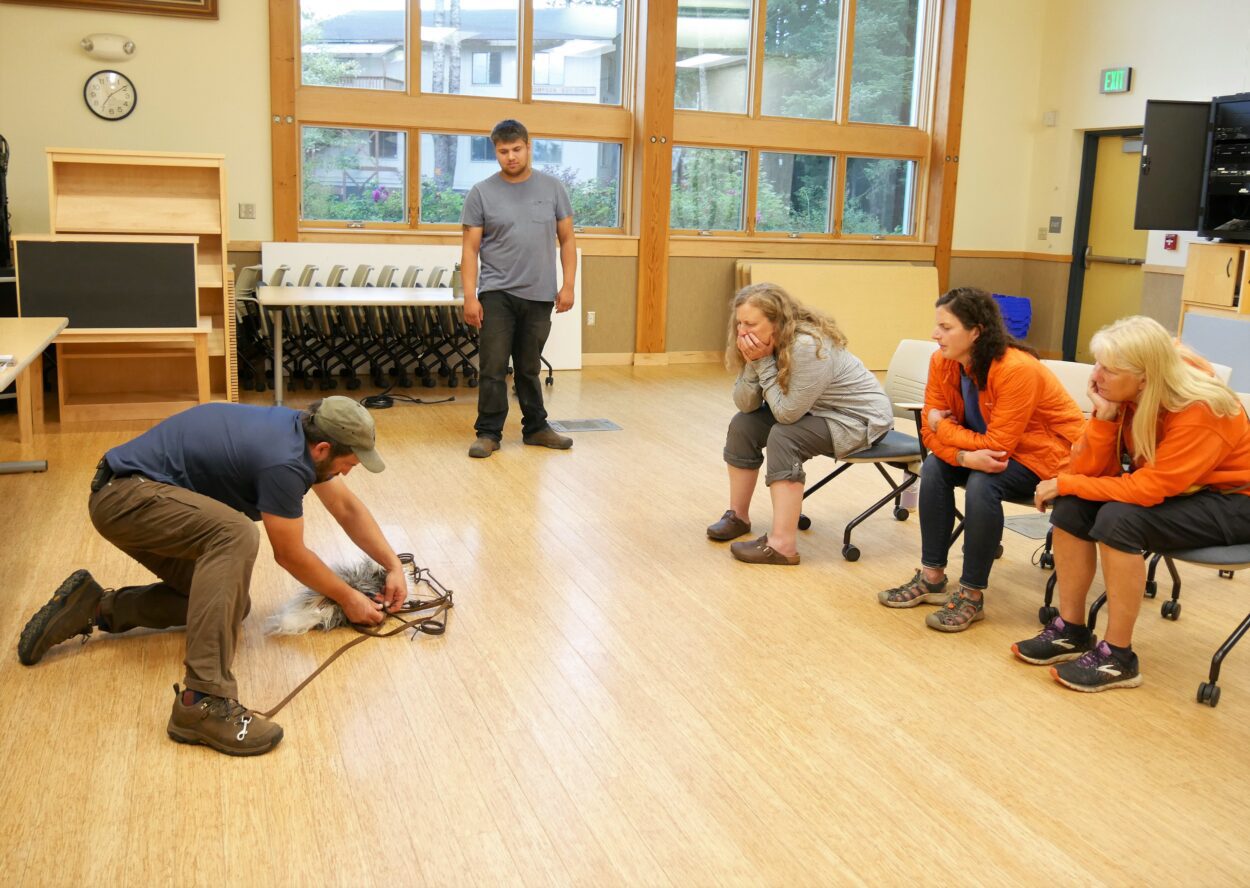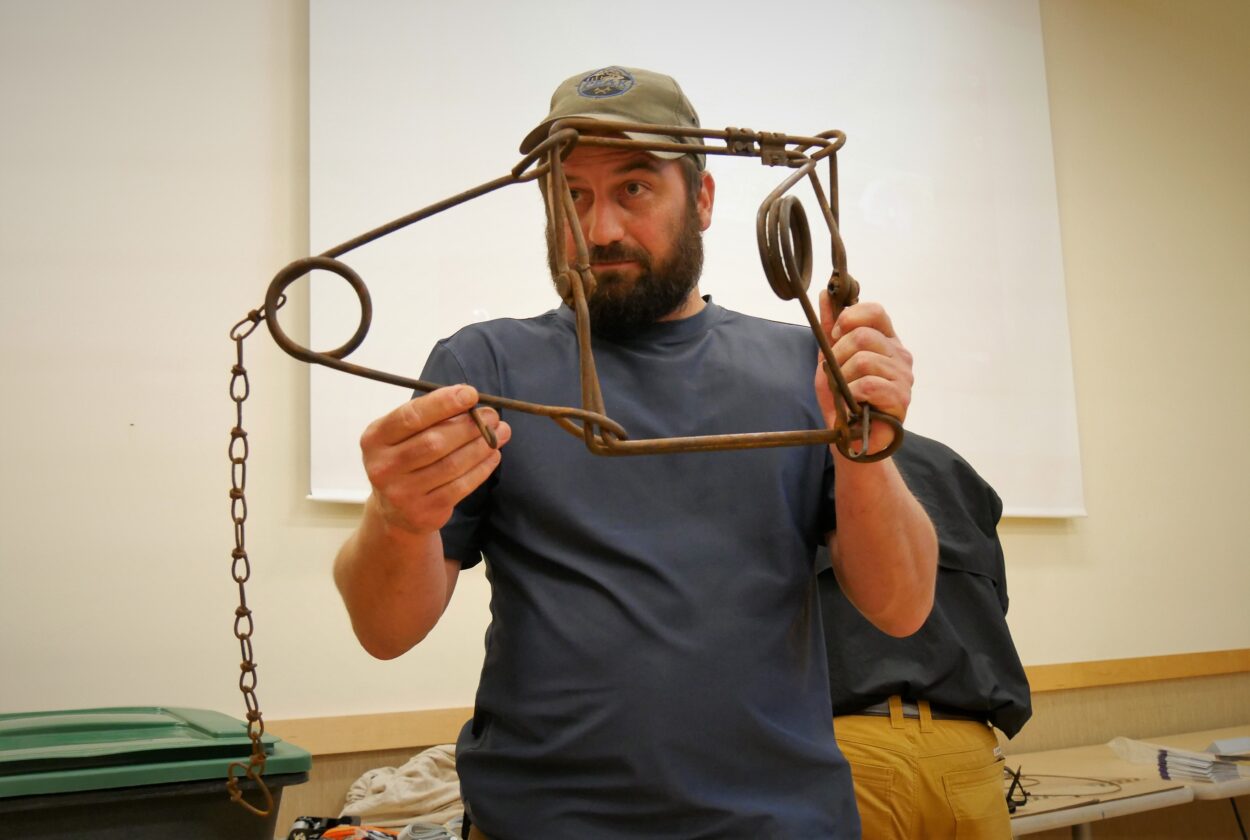
Alaskans trap and snare all over the state for food and fur. And every once in a while, a pet might get into one by accident. At a recent workshop in Petersburg, a state biologist and local trappers came together to teach the public what to do if it happens. CoastAlaska’s Angela Denning reports:
Eric Dreisbach stands at the front of a room in the Petersburg Public Library holding up a conibear trap.
He and others are using a stuffed husky to illustrate how to release dogs out of different types of traps and snares. It’s part of a presentation by the local office of the Alaska Department of Fish and Game. The conibear or body grip trap is one of the most worrisome. It’s the kind that snaps shut around an animal’s neck, with the intention of a humane kill.
“You’re going to want to work rapidly on this,” said Dreisbach.
He then demonstrates a trick for releasing the trap using a dog leash.
“You run it through, bring it back to you, run it through one more time,” he tells the onlookers.
By looping the leash through the trap, you can get more leverage by placing the leash’s handle on your foot and pulling the other end with your hand.
“Like right now,” Dreisbach said, “You could get him out, without even putting the safety on, you should be able to pull him out.”
Dreisbach knows a few tricks like this as a trapper and a pet owner. Six years ago, he was busy cutting wood with his family when one of his young Labs got caught in a wolf snare. He was able to release the dog, who ended up going to the vet for a bulging eye caused by ruptured blood vessels. But the dog quickly recovered and the family didn’t blame the trapper.
Eric’s wife, Lindsi Dreisbach, spoke to the local radio station about it.
“It was purely our fault,” she said. “Everything was marked and labeled as it should have been. It was just a case of losing track of our dog.”

How many pets get into traps and snares in Alaska is unknown. The Alaska Department of Fish and Game does not track that data. Anecdotally, it’s more common in other parts of the state, according to Frank Robbins, a state biologist managing lands in central Southeast. Previously, he worked in Glennallen and told the Petersburg crowd that it’s not in a trapper’s best interest to catch anything other than what they’re after. In general, he says, they’re a conscientious group.
“Most trappers are ethical and ethical trappers won’t place traps in places that are, you know, well known to dog walkers or trails that are super active,” Robbins said. “Unfortunately, it still might happen.”
Trapping seasons for various animals run from the fall through the spring but mostly in the winter months.
One of the traps used in the State’s presentation was found earlier in the day near a creek outside of town. Maybe it was from last year and forgotten or maybe it was someone intentionally setting out of season. Either way, it’s rare to run into them. Many Alaska communities have laws prevent trappers from setting in populated areas.
But Alaskans also like to go off trail with their dogs.
Workshop attendee, Karen Rosvold, says she sometimes takes her dog to a frozen slough for ice skating.
“If I’m ice skating and going from the Omer Creek little trail bridge all the way down to Blind Slough doing that whole circuit and then you’ll find, you know, beaver holes and stuff and I don’t know who’s setting back there,” she said.
To prevent problem encounters, some trappers like Adam Ware display notices nearby.
“I usually put it in a Zip lock bag, gallon size, like on a paper written in sharpie,” Ware said. “‘Hey, trapping area’. . .I make sure that stays up and visible.”
Ware was also helping at the workshop. He says he learned early on to be responsible for his traps.
“My dad raised me and my older brothers and my younger brother trapping,” he said. “Basically, since we were little kids we just went out and set and just basically teaching us how to live off the land.”
The state department along with the Alaska Trappers Association created a trappers code of ethics and a manual for getting pets out of traps. ADF&G also created how-to videos.
The trapping season in the Petersburg area runs November 1-April 30.









